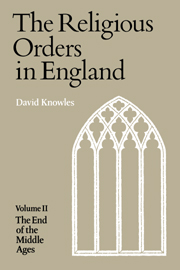Book contents
- Frontmatter
- Contents
- Preface
- List of Abbreviations
- Part One The Historical Framework
- Chap. I The opening of the period
- Chap. II Monks and canons at the university, 130c–1450
- Chap. III Patrons and architects: Ely and Gloucester
- Chap. IV Portraits of monks
- Chap. V Monks and friars in controversy
- Chap. VI Trends in speculation: Ockhamism, justification and grace
- Chap. VII Criticism of the religious in the fourteenth century
- Chap. VIII The spiritual life of the fourteenth century
- Chap. IX Developments within the orders: I
- Chap. X Developments within the orders: II
- Chap. XI The fortunes of the Cluniac houses and the alien priories
- Chap. XII The loosening of discipline
- Chap. XIII King Henry V
- Chap. XIV More portraits of monks
- Chap. XV The second century of visitation, 1350–1450
- Chap. XVI The spiritual life of the fifteenth century
- Part Two The Institutional Background
- Appendix I Chaucer's monk
- Appendix II Henry V and the Westminster recluse
- Appendix III Regulars as bishops
- Bibliography
- Index
Chap. II - Monks and canons at the university, 130c–1450
Published online by Cambridge University Press: 28 January 2010
- Frontmatter
- Contents
- Preface
- List of Abbreviations
- Part One The Historical Framework
- Chap. I The opening of the period
- Chap. II Monks and canons at the university, 130c–1450
- Chap. III Patrons and architects: Ely and Gloucester
- Chap. IV Portraits of monks
- Chap. V Monks and friars in controversy
- Chap. VI Trends in speculation: Ockhamism, justification and grace
- Chap. VII Criticism of the religious in the fourteenth century
- Chap. VIII The spiritual life of the fourteenth century
- Chap. IX Developments within the orders: I
- Chap. X Developments within the orders: II
- Chap. XI The fortunes of the Cluniac houses and the alien priories
- Chap. XII The loosening of discipline
- Chap. XIII King Henry V
- Chap. XIV More portraits of monks
- Chap. XV The second century of visitation, 1350–1450
- Chap. XVI The spiritual life of the fifteenth century
- Part Two The Institutional Background
- Appendix I Chaucer's monk
- Appendix II Henry V and the Westminster recluse
- Appendix III Regulars as bishops
- Bibliography
- Index
Summary
An account has already been given of the establishment of a house of studies at Oxford by the authorities of the chapter of the black monks of the province of Canterbury. The first tentative moves had issued, shortly before the end of the thirteenth century, in the occupation of an adequate area in Stockwell Street, on the site occupied by the original buildings of the present Worcester College. Owing directly to the circumstances of its origin Gloucester College, as it came to be called, was both in ownership and organization something of a patchwork. The abbot and community of Malmesbury were the ground landlords, and they also owned and occupied part of the building; the parts of the fabric common to all—chapel, hall and perhaps in time lecture rooms and library—had been erected and were maintained at the cost of the authorities of the provincial chapter, who had also secured an additional parcel of land; the apartments occupied by monks from the various houses were erected and maintained by the communities concerned. The head of the establishment was a prior, originally appointed by the abbot of Malmesbury; but the presidents appointed the regent master.
Gloucester College was not the only foothold of the black monks at Oxford. The northern province, which contained only four houses of any size, had made no attempt to set up a common house, but the great cathedral priory of Durham, which throughout the Middle Ages dominated the northern monastic scene, had begun to send monks to study at Oxford during the second priorate of Hugh of Darlington (1286/7–1289/90), the first purchase of land having been made in 1286.
- Type
- Chapter
- Information
- Religious Orders Vol 2 , pp. 14 - 28Publisher: Cambridge University PressPrint publication year: 1979



